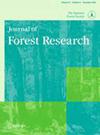四种针叶树种的单倍型解析从头基因组组装
IF 1.1
4区 农林科学
Q3 FORESTRY
引用次数: 0
摘要
裸子植物中的针叶树是重要的木材生产来源。由于针叶树的生命周期较长,因此其育种过程既费时又费力。基因组学可以在育种计划中加速选择优质树木或无性系;然而,针叶树的基因组通常是巨大的大小和表现出高杂合性。因此,长连续的针叶物种基因组组装的产生一直是困难的。本研究采用高保真(high-fidelity, HiFi)长读测序技术,对日本落叶松(Larix kaempferi)、Chamaecyparis obtusa、Cryptomeria japonica和Cunninghamia lanceolata四种针叶树的基因组进行了测序和组装。4个物种的基因组总组装量分别为13.5 Gb(山蕨)、8.5 Gb(黑桫椤)、9.2 Gb(日本槐树)和11.7 Gb(杉树),覆盖了平均估计基因组大小的99.6%。拼接序列的N50值(表示拼接序列的连续度)为1.2 Mb至16.0 Mb,拼接序列平均包含胚胎植物中保存的89.2%的单拷贝同源基因。代表替代单倍型的组装序列覆盖了70.3-95.1%的基因组,表明四种针叶树基因组具有高杂合性水平。本研究获得的基因组序列信息是树木遗传学和基因组学的一个里程碑,将促进针叶树的基因发现、等位基因挖掘、系统发育和进化研究,并加速森林树木育种计划。本文章由计算机程序翻译,如有差异,请以英文原文为准。
Haplotype-resolved de novo genome assemblies of four coniferous tree species
Coniferous trees in gymnosperm are an important source of wood production. Because of their long lifecycle, the breeding programs of coniferous tree are time- and labor-consuming. Genomics could accelerate the selection of superior trees or clones in the breeding programs; however, the genomes of coniferous trees are generally giant in size and exhibit high heterozygosity. Therefore, the generation of long contiguous genome assemblies of coniferous species has been difficult. In this study, we employed high-fidelity (HiFi) long-read sequencing technology to sequence and assemble the genomes of four coniferous tree species, Larix kaempferi, Chamaecyparis obtusa, Cryptomeria japonica, and Cunninghamia lanceolata. Genome assemblies of the four species totaled 13.5 Gb (L. kaempferi), 8.5 Gb (C. obtusa), 9.2 Gb (C. japonica), and 11.7 Gb (C. lanceolata), which covered 99.6% of the estimated genome sizes on average. The contig N50 value, which indicates assembly contiguity, ranged from 1.2 Mb in C. obtusa to 16.0 Mb in L. kaempferi, and the assembled sequences contained, on average, 89.2% of the single-copy orthologs conserved in embryophytes. Assembled sequences representing alternative haplotypes covered 70.3–95.1% of the genomes, suggesting that the four coniferous tree genomes exhibit high heterozygosity levels. The genome sequence information obtained in this study represents a milestone in tree genetics and genomics, and will facilitate gene discovery, allele mining, phylogenetics, and evolutionary studies in coniferous trees, and accelerate forest tree breeding programs.
求助全文
通过发布文献求助,成功后即可免费获取论文全文。
去求助
来源期刊

Journal of Forest Research
农林科学-林学
CiteScore
3.00
自引率
6.70%
发文量
62
审稿时长
3 months
期刊介绍:
Journal of Forest Research publishes original articles, reviews, and short communications. It covers all aspects of forest research, both basic and applied, with the aim of encouraging international communication between scientists in different fields who share a common interest in forest science.
 求助内容:
求助内容: 应助结果提醒方式:
应助结果提醒方式:


